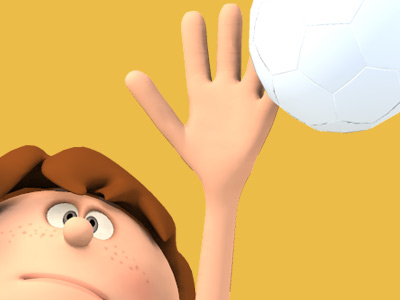Volleyball Pass
Also called reception, the pass is the attempt by a team to properly handle the opponent's serve, or any form of attack. Proper handling includes not only preventing the ball from touching the court, but also making it reach the position where the setter is standing quickly and precisely.
The skill of passing involves fundamentally two specific techniques: underarm pass, or bump, where the ball touches the inside part of the joined forearms or platform, at waist line; and overhand pass, where it is handled with the fingertips, like a set, above the head. Either are acceptable in professional and beach volleyball, however there are much tighter regulations on the overhand pass in beach volleyball.
-
Outline

SPORTS WORLD
Volleyball
Competitive teams master six basic skills: serve, pass, set, attack, block and dig. Each of these skills comprises a number of specific techniques that have been introduced over the years and are now considered standard practice in high-level volleyball.
Rules of the game: A player from the serving team throws the ball into the air and attempts to hit the ball so it passes over the net on a course such that it will land in the opposing team's court (the serve).
Players: There are 5 positions filled on every volleyball team at the elite level. Setter, Outside Hitter/Left Side Hitter, Middle Hitter, Opposite Hitter/Right Side Hitter and Libero/Defensive Specialist.
Formations: The three standard volleyball formations are known as "4–2", "6–2" and "5–1", which refers to the number of hitters and setters respectively. 4–2 is a basic formation used only in beginners' play, while 5–1 is by far the most common formation in high-level play.
Team play: Volleyball is essentially a game of transition from one of the above skills to the next, with choreographed team movement between plays on the ball. These team movements are determined by the teams chosen serve receive system, offensive system, coverage system, and defensive system.
Skills
Serve: A player stands behind the inline and serves the ball, in an attempt to drive it into the opponent's court.
Pass: Proper handling includes not only preventing the ball from touching the court, but also making it reach the position where the setter is standing quickly and precisely.
Set: The main goal of setting is to put the ball in the air in such a way that it can be driven by an attack into the opponent's court.
Attack: The object of attacking is to handle the ball so that it lands on the opponent's court and cannot be defended.
Block: Blocking refers to the actions taken by players standing at the net to stop or alter an opponent's attack.
Dig: Digging is the ability to prevent the ball from touching one's court after a spike or attack, particularly a ball that is nearly touching the ground.

Volleyball
Competitive teams master six basic skills: serve, pass, set, attack, block and dig. Each of these skills comprises a number of specific techniques that have been introduced over the years and are now considered standard practice in high-level volleyball.
Skills




RESOURCES
This article uses material from the Wikipedia article "Volleyball", which is released under the Creative Commons Attribution-Share-Alike License 3.0.
© Stories Preschool. All Rights Reserved.
"Building Cool Educational Stuff for children and adults!"


Historic Battles
Wars and military campaigns are guided by strategy, whereas battles take place on a level of planning and execution known as operational mobility.
View Historic Battles »


Historic People
A historical figure is a famous person in history, such as Alexander the Great, Admiral Yi Sun-Shin, Abraham Lincoln, George Washington, Christopher Columbus, or Napoleon Bonaparte.
View Historic People »


Historic Timeline
Describes the history of humanity as determined by the study of archaeological and written records. Ancient recorded history begins with the invention of writing.
View Historic Timeline »

Historic Legends
Beings in myths are generally gods and goddesses, heroes and heroines, or animals and plants. Most myths are set in a timeless past before recorded time or beginning of the critical history.
View Historic Legends »

Sports World
Includes competitive games which, through casual or organized participation, aim to use, maintain or improve physical ability and skills while providing enjoyment to participants.
View Sports World »

Untold Stories
If you have any questions, feedback or suggestions for us, we'd like to hear from you. Please feel free to contact us!
Contact Us

Historic Battles
Wars and military campaigns are guided by strategy, whereas battles take place on a level of planning and execution known as operational mobility.
View Historic Battles »

Historic People
A historical figure is a famous person in history, such as Alexander the Great, Admiral Yi Sun-Shin, Abraham Lincoln, George Washington, Christopher Columbus, or Napoleon Bonaparte.
View Historic People »

Historic Timeline
Describes the history of humanity as determined by the study of archaeological and written records. Ancient recorded history begins with the invention of writing.
View Historic Timeline »

Historic Legends
Beings in myths are generally gods and goddesses, heroes and heroines, or animals and plants. Most myths are set in a timeless past before recorded time or beginning of the critical history.
View Historic Legends »

Sports World
Includes competitive games which, through casual or organized participation, aim to use, maintain or improve physical ability and skills while providing enjoyment to participants.
View Sports World »

Untold Stories
If you have any questions, feedback or suggestions for us, we'd like to hear from you. Please feel free to contact us!
Contact Us
Historic Battles
Wars and military campaigns are guided by strategy, whereas battles take place on a level of planning and execution known as operational mobility.
View Historic Battles »

Historic People
A historical figure is a famous person in history, such as Alexander the Great, Admiral Yi Sun-Shin, Abraham Lincoln, George Washington, Christopher Columbus, or Napoleon Bonaparte.
View Historic People »

Historic Timeline
Describes the history of humanity as determined by the study of archaeological and written records. Ancient recorded history begins with the invention of writing.
View Historic Timeline »

Historic Legends
Beings in myths are generally gods and goddesses, heroes and heroines, or animals and plants. Most myths are set in a timeless past before recorded time or beginning of the critical history.
View Historic Legends »

Sports World
Includes competitive games which, through casual or organized participation, aim to use, maintain or improve physical ability and skills while providing enjoyment to participants.
View Sports World »

Untold Stories
If you have any questions, feedback or suggestions for us, we'd like to hear from you. Please feel free to contact us!
Contact Us